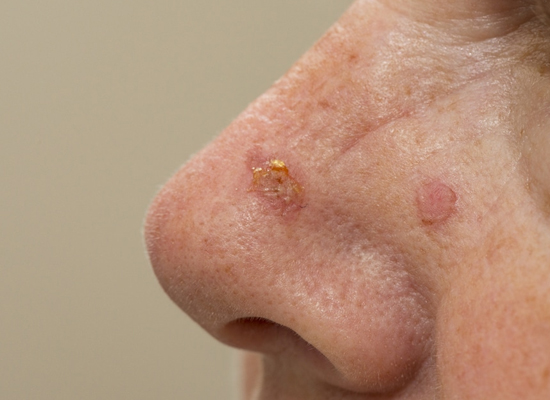
If you’ve noticed rough, scaly patches on your skin, especially in sun-exposed areas, you may have a common skin lesion called an actinic keratosis (AK). While these spots might seem harmless at first glance, they’re precancerous lesions caused by long-term sun damage. At Dermatology Healthcare Excellence, our board-certified dermatologists offer expert diagnosis and a variety of treatment options for actinic keratoses to help prevent skin cancer and keep your skin healthy.erous AKs especially raises your lifetime risk for SCC.
What Are Actinic Keratoses?
Actinic keratoses are rough, dry, scaly spots or bumps that form on skin that has been exposed to ultraviolet (UV) rays over time, typically from the sun or tanning bed use. These lesions are considered precancerous and can develop into squamous cell carcinoma (SCC), a type of skin cancer.
Quick Facts About Actinic Keratoses:
- Caused by long-term sun exposure
- Found most commonly in older adults and fair-skinned individuals
- Considered precancerous, with 5–10% progressing to skin cancer
- Often appear on the face, lips, scalp, ears, neck, arms, shoulders, and chest
- Sign of chronic sun damage, which raises your lifetime risk of developing skin cancer
If you’ve had one AK, there’s a good chance you’ll develop more. That’s why early detection and treatment are essential.
What Does an Actinic Keratosis Look Like?
AKs can vary in appearance, which makes them easy to overlook or mistake them for something less serious like dry skin, eczema, or age spots. Most are small (less than ¼ inch), flat or slightly raised, and rough to the touch, often described as feeling like sandpaper.
Common signs of AKs include:
- Dry, scaly patches that don’t go away
- Pink, red, tan, or brown discoloration
- A rough or gritty texture
- Tenderness, itching, burning, or bleeding
- On the lips, AKs may appear as persistent white, scaly patches, a condition known as actinic cheilitis
These lesions may come and go but usually reappear in the same spot. If you’re unsure whether a spot is just dry skin or something more, it’s best to have it evaluated by a dermatologist.
Who Is at Risk for Actinic Keratoses?
While AKs can affect anyone, certain risk factors increase your chances of developing them.
Risk factors include:
- Fair skin, blue or green eyes, and blonde or red hair
- History of frequent or intense sun exposure
- Use of tanning beds
- Older age (usually over 40)
- Weakened immune system, such as from organ transplantation or cancer treatment
- Living in sunny climates or spending a lot of time outdoors
Immunosuppressed individuals, especially transplant recipients, are at significantly higher risk of developing both AKs and skin cancer. If this applies to you, routine skin checks are especially important.
Why Actinic Keratoses Should Be Treated
Because AKs are precancerous, treating them early reduces the risk of them turning into squamous cell carcinoma (SCC). Even if an AK seems small or harmless, it could progress to cancer over time, or signal that more sun-damaged skin exists beneath the surface.
At DHE, we believe in proactive skin care. Our goal is to treat visible lesions, prevent new ones from forming, and monitor your skin for any changes.
Actinic Keratosis Treatment Options
There are many safe and effective ways to treat AKs. The best treatment depends on:
- Whether or not you are immunocompromised
- How many AKs you have
- Their location and appearance
- Your medical history and skin type
In-Office Procedures
1. Cryosurgery
The most common treatment for AKs involves freezing the lesion(s) with liquid nitrogen. The AK typically crusts over and falls off within a few days.
- Quick and effective
- Mild discomfort and temporary blistering may occur
- Suitable for a few isolated spots
2. Curettage and Electrodesiccation
Used for thicker or stubborn AKs. The lesion is scraped off with a surgical tool called a curette and then cauterized to destroy remaining abnormal cells.
- Great for hyperkeratotic (thick) AKs
- Minimal downtime
3. Photodynamic Therapy (PDT) – Blue Light Therapy
Ideal for patients with multiple AKs or those who develop new lesions frequently.
- A photosensitizing solution is applied to the skin
- After an incubation period, a blue light is used to activate the solution
- The treated cells are destroyed while healthy skin remains intact
- Expect temporary redness, peeling, and light sensitivity
- Often requires 2 treatments spaced 4-6 weeks apart
4. Chemical Peels
Medical-grade chemical peels help slough off sun-damaged skin and stimulate new skin growth.
- Only available in a clinical setting
- May cause temporary redness and flaking
- Effective for widespread sun damage
- Not covered by insurance
At-Home Prescription Medications
5. 5-Fluorouracil (5-FU) Cream (Efudex, Carac, Tolak)
A topical chemotherapy agent that targets abnormal cells.
- Applied once or twice daily for 3–6 weeks
- Treats both visible and subclinical AKs
- Causes redness, crusting, and irritation during treatment
- Not suitable for pregnant patients
6. Diclofenac Sodium Gel (Voltaren)
A non-steroidal anti-inflammatory drug (NSAID) that reduces AK cells with fewer side effects, but is also less effective without 5-FU and requires a much longer application period.
- Applied twice daily for 2–3 months
- Mild redness or irritation may occur
- Sun protection is crucial during use
7. Tirbanibulin Ointment (Klisyri)
A newer treatment approved for use on the face and scalp.
- Applied once daily for 5 consecutive days
- Minimal side effects, such as mild irritation
- Easy, short course of treatment
What to Expect During and After Treatment
Most AK treatments are performed in-office and require little downtime, but the healing process varies depending on the method used.
General post-treatment care tips:
- Keep the treated area clean and protected
- Use gentle skincare and avoid harsh scrubbing
- Wear broad-spectrum SPF 30+ sunscreen daily
- Avoid direct sun exposure, especially after light-based treatments, until skin is fully healed from treatment.
Your provider will give you specific aftercare instructions based on your treatment plan.
Preventing Future Actinic Keratoses
Once you’ve had actinic keratoses, you’re more likely to develop more in the future. Preventive skincare and sun safety are essential.
Sun protection tips:
- Use broad-spectrum sunscreen daily, even on cloudy day, and even if you are not planning to go outdoors
- Wear wide-brimmed hats, sunglasses, and long sleeves when outdoors
- Avoid tanning beds
- Perform regular self-skin exams
- Schedule annual skin checks with a board-certified dermatologist
Our dermatology team is here to help you protect your skin for the long term.
